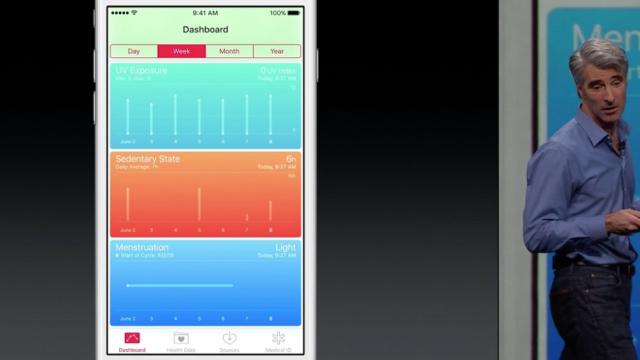There were hints right away that yesterday’s WWDC keynote would be different. Tim Cook opened with an anecdote about an Apple-sponsored scholarship competition to engage students in technology careers, specifically mentioning that the winner was a 12-year-old girl from New York.
Yes, there were more women onstage at an Apple WWDC keynote than in the past five years combined. But even more importantly — and something I truly was not prepared to ever see — developers added a critical female-only health-tracking tool to the latest iOS update. This is good news not just for women, but for anyone who’s calling for more inclusion in technology.
Before yesterday, Apple had only put six women onstage at its events since 1997. During yesterday’s keynote, that number improved by a third in less than two hours. Jennifer Bailey, VP of Internet Service, took the stage to speak about advancements in Apple Pay. A few speakers later, VP of Product Marketing Susan Prescott gave an energetic presentation about the new News app. These women were the first female Apple execs to be onstage since CTO Ellen Hancock spoke at a MacWeek event in 1997.
But what followed was surprising — and perhaps an even more encouraging sign for those calling on Silicon Valley to recognise diversity. A year ago, many women tech writers took Apple to task for not including any female health features in HealthKit, namely a simple way for women to track their periods, which can help women get pregnant (or more frequently, avoid pregnancy). It can also be helpful in general to know when you’re about to get your period, for all the awkward/mundane reasons you might expect.
While introducing new updates to HealthKit, Craig Federighi listed some of the new features as an iPhone graphic animated behind him: “hydration, UV exposure, and reproductive health.” All I could see was a label on the chart that read “light” (which I assume means flow level?) with a line that stretched across the past four days. Hopefully it will also do things like help track basal body temperature, another important fertility cue.
It was only about two seconds of the keynote, but just seeing the word “menstruation” scroll behind Federighi represented a real turning point in Apple’s diversity efforts. The only thing that would have made this moment better would have been if Apple had allowed a woman who worked on it to introduce the new feature.
It’s true that Apple appeared to be trying exceptionally hard to be more gender and racially inclusive in the many (many) videos it played in the keynote. But I’d argue that a video about the “history of music” is not the same as showing the actual people behind the products. Apple might be listening to the 50 per cent of its users that need a period tracker, but the diversity which is so needed in tech products has to originate from the designers and developers themselves. That’s why critics are right to focus on the (low) numbers of women in leadership positions at tech companies.
That said, there is one place where Apple actually fares better than Google and Microsoft, according to a Bloomberg report:
Apple actually employs more women in tech positions than Google (20 per cent vs. 18 per cent), and women make up a higher percentage of leadership positions (28 per cent to 22 per cent). Three women are on Google’s board compared with Apple’s two. Microsoft lags behind both companies, with only 17 per cent of its tech jobs and 18 per cent of its leadership roles held by women.
Why does any of this matter? Cook said it beautifully in an interview with Mashable: “I think the most diverse group will produce the best product, I firmly believe that.” This doesn’t just mean putting a diverse group of people onstage, although that is important. It means acknowledging that not every user is going to be an affluent white male who’s deliberating between bands on Apple Watches. Apple’s not there yet — but maybe yesterday’s keynote was a start.
